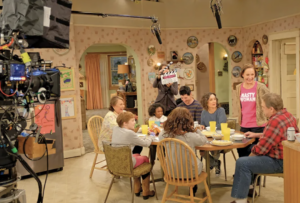
With high-quality shows coming at viewers from streaming services, cable channels and even broadcast networks, TV execs and fans alike are all in on the new Golden Age of Television. And most of these programs — for example, HBO’s “Westworld,” Hulu’s “The Handmaid’s Tale” and CBS’ “The Good Fight” — have a decidedly single-camera cinematic look.
But there’s another TV format that has been the industry’s bread and butter since “I Love Lucy” and “The Honeymooners” kept people glued to their screens in the 1950s — the multicamera sitcom, less popular today than it was during its heyday but still going strong. One of the latest multicam shows: the revival of “Roseanne,” the ABC sitcom with Roseanne Barr and John Goodman that reigned over the airwaves in the early ’90s. The reboot will debut March 27 on the same network.

With a multicam shooting setup, several cameras record the action in front of a live studio audience in relatively flat lighting. Single-camera shows usually involve more shooting time and allow more subtle lighting to enhance the storytelling.
“I think you have different formats that are currently in vogue, especially on premium cable networks,” says Tom Werner, one of TV’s most successful sitcom producers and showrunner on “The Cosby Show” and “3rd Rock From the Sun,” as well as the original “Roseanne” and its revival. “But the format of multicamera comedy has never disappeared, as you can see with revivals like ‘Roseanne’ and ‘Will & Grace.’ After all, the biggest show on TV is ‘The Big Bang Theory.’”
While the multicamera style has endured for more than half a century, it hasn’t remained stagnant, evolving in key ways. As Werner observes, the new “Roseanne” has a more cinematic appearance than its predecessor, with a style he describes as richer and more sophisticated. “The look of the show is more film-oriented; the lighting is more nuanced, not as bright,” he says. It comes down to what the audience expects in 2018, he adds. “The visual quality is a lot richer. I think audiences are more comfortable now with more nuanced looks.”

Assistant director Amy Brown agrees. A longtime veteran of the sitcom world, she was with the crew of the original “Roseanne” from the pilot through the entirety of the series, and she knows better than anyone the differences and similarities between that show and the new one. “It’s very much the same,” she notes, “but the production is much more complicated. The whole show has become bigger and more complicated — like life itself.”
In the early ’90s, Brown says, a multicamera sitcom would be staged almost like a play, divided into two acts with four or five scenes per act. Today, television moves faster, and people expect more variety and dynamism from even a multicam show. “We’ve adapted to the quick-cut mentality of single-camera television. In the reboot, we have three acts and probably 20 scenes.”
More scenes mean more people and a longer shooting schedule. “Each scene requires a new setup, and every setup adds time,” Brown says. “There are wardrobe changes; cameras have to be moved. The scheduling and shooting have become much more complicated.” Brown remembers working on the original “Roseanne” two or three days a week at most. “Now there’s no question this is a five-day job, and we have an additional AD come in to help.”

“We’ve adapted to the quick-cut mentality of single-camera television. In the reboot, we have three acts and probably 20 scenes.”
Amy Brown, “Roseanne” assistant director
Other aspects of multicamera production have also changed over the past quarter century, particularly in terms of technology, which has evolved drastically. “Roseanne” used to be recorded on analog videotape, but now it’s shot on digital formats, in HD. The cameras are smaller and lighter, and things run more smoothly.
“You don’t have the big truck outside; you don’t have people calling, ‘Roll tape.’ A lot of that went away,” Brown says. One of the more noticeable differences: “I don’t have to count down from five to action anymore.”
People like Brown, who have worked mainly on multicam productions, felt the pinch when that format was briefly on the wane, but the return of shows like “Roseanne” means an influx of work for multicamera sitcom crews.
“In the late ’90s there were few multicamera sitcoms,” she recalls. “There were whole seasons when I went without work.” But “Roseanne” suggests a degree of permanence. “The format is back!” says Brown. “It’s crazy, and it’s amazing.”
